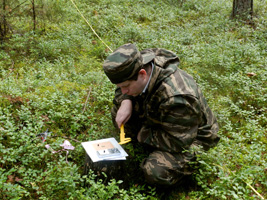|
|
Руководитель сектора Коваленко Снежана Александровна кандидат с.-х. наук, доцент тел. +375 232 34 07 86 |
Сектор образован в 1992 г.
Кадровый состав сектора 7 человек, в том числе
2 кандидата наук, 5 научных сотрудников.
В секторе имеется коллекция штаммов грибов, являющаяся научным объектом, который составляет национальное достояние.


| The division studies the condition, productivity and problems of rehabilitation of forest lands and berry and mushroom fields. The staff also works on the advancement of the methods of record, assessment and prediction of forest food and medicinal resources and develops new processes of establishment of plantations of economically valuable berry-bearing plants and cultivation of higher edible and medicinal basidiomycetes on a commercial scale. |
Основные направления научных исследований
- разработка научных основ воспроизводства и рационального использования пищевых и лекарственных ресурсов леса, и их охраны;
- разработка научно-методической базы мониторинга, долго- и краткосрочного прогнозирования ресурсной базы дикорастущих ягод и съедобных грибов;
- методология рационального природопользования;
- разработка научных основ промышленных технологий культивирования грибов-ксилофилов и ягодных растений подсемейства брусничные;
исследование закономерностей онтоморфогенеза высших съедобных и лекарственных грибов и лесных ягодных растений в природных и искусственных экосистемах; - сохранение, пополнение и надлежащее функционирование Коллекции штаммов базидиальных грибов ‒ научного объекта, который составляет национальное достояние страны.
Прикладные исследования
- разработка нормативной базы промышленного грибоводства в Республике Беларусь;
- разработка и внедрение технологий промышленного выращивания посевного мицелия и плодовых тел съедобных и лекарственных базидиальных грибов;
- совершенствование агротехнических приемов плантационного выращивания ягодных растений подсемейства брусничные.
Основные разработки сектора
- методика и определение биологических и эксплуатационных ресурсов ягодных растений и съедобных грибов, посредством мониторинга дикорастущих ягодных растений в соответствии с административно-территориальным делением Беларуси;
- методы биологической рекультивации антропогенно нарушенных болотных экосистем (выработанных торфяников) путем создания плантаций ягодников подсемейства брусничные;
- система мероприятий по повышению продуктивности ягодников подсемейства брусничные в естественных и искусственных фитоценозах;
- нормативно-технологическая база культивирования съедобных и лекарственных грибов (вешенка, сиитаке, опенок зимний, рейши) в условиях регулируемого микроклимата и на специализированных плантациях;
- коллекция штаммов базидиальных грибов и коллекционно-маточные посадки форм и сортов ягодных растений подсемейства брусничные - перспективных продуцентов веществ пищевого и медико-биологического назначения;
- селектирован первый белорусский сорт голубики - Памяти Волчкова.
Перспективные планы
- мониторинг хозяйственно значимых видов лесных ягодных растений и грибов;
- интродукция редких и исчезающих видов и форм ягодных растений и грибов в природных экосистемах;
- исследование закономерностей онтоморфогенеза высших съедобных и лекарственных грибов пищевого и лечебно-профилактического назначения;
- разработка технологий промышленного культивирования новых видов и высоко-продуктивных форм ягодных растений, высших съедобных и лекарственных грибов.


DIVISION OF FOREST FOOD & MEDICINAL RESOURCES
Head of the Division: Kovalenko Snezhana, Candidate of Agricultural Sciences
Tel. +375 232 34 07 86
The division was formed in 1992. The staff of the division is represented by 7 employees, including 2 candidate of science, 5 research scientists.
The main areas of fundamental research:
- Development of scientific framework for reproduction and rational use of forest food and medicinal resources, and their protection;
- Development of a scientific and methodological basis for monitoring, long-term and short-term forecasting of the resource base of wild berries and edible mushrooms;
- Methodology of environmental rational management;
- Development of the scientific framework for the commercial cultivation technologies for xylophilous fungi and berry plants of the subfamily Vacciniaceae;
- Study of the ontomorphogenesis patterns of higher edible and medicinal mushrooms and wild berry plants in natural and artificial ecosystems;
- Preservation, replenishment and proper functioning of the Basidiomycota strain collection - a scientific object that constitutes the national heritage of the country.
Applied research:
- Development of the regulatory framework for commercial mushroom production in the Republic of Belarus;
- Development and implementation of technologies for the commercial cultivation of seed mycelium and fruit bodies of edible and medicinal basidium fungi;
- Improvement of agrotechnical methods of plantation cultivation of berry plants of the subfamily Vacciniaceae
Main R&D Products:
- Methods and determination of biological and operational resources of berry plants and edible mushrooms, through the monitoring of wild berry plants in accordance with the administrative and territorial division of Belarus;
- Methods of biological reclamation of man-impacted mire ecosystems (depleted peatlands) by creating plantations of berries of the subfamily Vacciniaceae;
- System of measures to increase the productivity of berries of the subfamily Vacciniaceae in natural and artificial phytocenoses;
- Regulatory and technological base for cultivation of edible and medicinal mushrooms (oyster, shiitake, velvet foot, reishi) in a regulated microclimate and on specialized plantations;
- Collection of basidium fungi strains and collection-stool beds of the forms and varieties of berry plants of the subfamily Vacciniaceae – the promising producers of food and medical-biological substances
Perspective plans:
- Monitoring of economically important species of forest berry plants and mushrooms;
- Introduction of rare and endangered species and forms of berry plants and mushrooms in natural ecosystems;
- Study of the ontomorphogenesis patterns of higher edible and medicinal mushrooms for food and therapeutic purposes;
- Development of technologies for the commercial cultivation of new species and highly productive forms of berry plants, higher edible and medicinal mushrooms.










